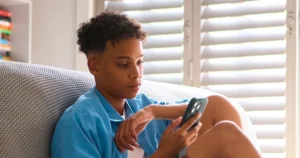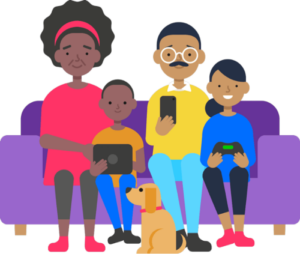From virtual reality to social media to their mobile device, children use technology in many different ways. How your child uses technology, though, might be different to another child. So it’s important to understand their personal interests.
Summary
- The majority of 3-4-year-olds engage with tablets which have a range of apps.
- Use parental controls on mobile and broadband networks as a starting point.
- Discuss children’s online reputation to help them make positive choices.
- Follow these 4 tips to start children’s online safety early.
- Find resources to support children’s online safety.
The technology young people use
In 2022, Ofcom reported that 78% of children aged 3-4 now use a tablet. As they age, they begin to use technology like smartphones and mobile devices over tablets. Regardless of the device, all of these have the potential to connect to the internet. Tablets are becoming the technology of choice for millions of kids in Britain.
Apps and what to look out for
Applications or apps are available for tablets and smartphones. They’re often free to download but a great many require users to buy something before they can do anything that is really useful or interesting. Sometimes you can only get the ‘free’ app by registering a credit card, which, of course, will almost always belong to one of the parents.
A number of families receive an enormous shock when the statement comes in at the end of the month. They might discover their child has unwittingly spent perhaps a thousand pounds or more on shiny laser guns, sonic shields or pink glittery ponies. Keep an eye on that and set parental controls to manage what permissions they have when it comes to spending in the Apple or Google Play stores.
Manage technology with parental controls
It can be very difficult for parents to support or supervise their children’s use of technology when they’re out and about. However, all mobile phone networks and the larger internet service providers supply filters as standard. These can be a great help keeping out inappropriate content such as pornography which can have a detrimental effect on many young people’s attitudes towards sex and sexuality.
Manage online reputation
Dealing with children’s online behaviour requires a different approach. Take the issue of sexting, for example. Some youngsters have taken pictures of themselves engaging in sexual acts that they then sent to their boyfriend or girlfriend as a token of what they think, at the time, is their love for each other. However, this is in fact not just illegal but also abusive as such behaviour is not developmentally appropriate.
Several youngsters use technology to try and hide their activity on a tablet or smartphone by using so-called decoy or anonymity apps. However, in the end they will not prevent a police officer, a ‘mate’ or a clever Head Teacher at school from seeing how the phone or tablet has been used.
Watch out for these apps on your children’s devices. If you see them, or anything else you are worried about or are not sure of, sit down and talk to your child about your concerns. Get them to explain to you exactly what each app is and show you how it works. It’s a great way to get a conversation going about all of these issues.
4 things you can do now
- Make sure the content filters are turned on and working
- Remove your credit card details from your child’s smartphone or tablet to limit in-app purchases
- Get your child to explain to you what he or she does with every app they have loaded on to their smartphone or tablet
- Learn about decoy apps and watch out for them in the technology your child uses







